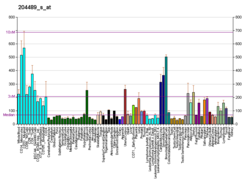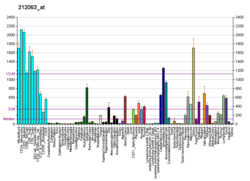チログロブリン
| TG | |||||||||||||||||||||||||
|---|---|---|---|---|---|---|---|---|---|---|---|---|---|---|---|---|---|---|---|---|---|---|---|---|---|
| 識別子 | |||||||||||||||||||||||||
| 記号 | TG, AITD3, TGN, thyroglobulin | ||||||||||||||||||||||||
| 外部ID | OMIM: 188450 MGI: 98733 HomoloGene: 2430 GeneCards: TG | ||||||||||||||||||||||||
| |||||||||||||||||||||||||
| |||||||||||||||||||||||||
| |||||||||||||||||||||||||
| |||||||||||||||||||||||||
| オルソログ | |||||||||||||||||||||||||
| 種 | ヒト | マウス | |||||||||||||||||||||||
| Entrez | |||||||||||||||||||||||||
| Ensembl | |||||||||||||||||||||||||
| UniProt | |||||||||||||||||||||||||
| RefSeq (mRNA) | |||||||||||||||||||||||||
| RefSeq (タンパク質) | |||||||||||||||||||||||||
| 場所 (UCSC) | Chr 8: 132.87 – 133.13 Mb | Chr 8: 66.54 – 66.72 Mb | |||||||||||||||||||||||
| PubMed検索 | [3] | [4] | |||||||||||||||||||||||
| ウィキデータ | |||||||||||||||||||||||||
| |||||||||||||||||||||||||
チログロブリン[5]またはサイログロブリン(Thyroglobulin、Tg)は、甲状腺の濾胞細胞で産生される660kDaの二量体糖タンパク質であり、全て甲状腺中で使用される。Tgは甲状腺濾胞の細胞外コンパートメントに1リットルあたり数百グラム分泌・蓄積され、甲状腺のタンパク質量の約半分を占める[6]。ヒトTG(hTG)は、合成時には2768アミノ酸を含むサブユニットのホモ二量体である(成熟タンパク質ではN末端から19アミノ酸の短いシグナルペプチドが取り除かれる)[7]。
チログロブリンは、全ての脊椎動物において、甲状腺ホルモンの主要な前駆体である。甲状腺ホルモンは、チログロブリンのチロシン残基がヨウ素と結合し、その後タンパク質が切断される事によって生成される。各チログロブリン分子には約100~120個のチロシン残基があるが、濾胞コロイド内でチロペルオキシダーゼによるヨウ素化を受けるのは、その内の僅か20個である。従って、1つのTg分子は約10個の甲状腺ホルモン分子を形成する[6]。
機能
[編集]
チログロブリン(Tg)は、甲状腺ホルモンであるチロキシン(T4)とトリヨードチロニン(T3)を合成する際の基質となり、不活性型の甲状腺ホルモンとヨウ素を甲状腺濾胞の濾胞内腔に貯蔵している[8]。
新たに合成された甲状腺ホルモン(T3とT4)はチログロブリンに結合しており、濾胞内のコロイドを構成する。甲状腺刺激ホルモン(TSH)の刺激を受けると、コロイドは甲状腺濾胞の内腔から周囲の甲状腺濾胞上皮細胞にエンドサイトーシスされる。その後、コロイドはプロテアーゼによって切断され、チログロブリンからT3とT4が分離する[9]。
活性型の甲状腺ホルモンであるT3とT4は血中に放出され、一部は血漿タンパク質に結合した状態になり、チログロブリンは濾胞内腔に戻され、引き続き甲状腺ホルモン合成の基質としての役割を果たす事になる[10]。
臨床的意義
[編集]半減期と臨床的上昇
[編集]チログロブリンの代謝は、甲状腺でのタンパク質のリサイクルを介して肝臓で行われる。循環しているチログロブリンの半減期は65時間である。甲状腺切除後、チログロブリン濃度が検出されなくなるまでには、何週間も掛かる事がある。チログロブリン濃度は、甲状腺を摘出した後、数週間から数ヶ月間は定期的に検査すべきであろう[11]。
甲状腺乳頭癌または濾胞癌の患者では、その後も引き続き検査すべきである。その後のチログロブリン濃度の上昇は、甲状腺乳頭癌または濾胞癌の再発の徴候である[11]。その為、血中チログロブリン濃度は、主に一部の甲状腺癌(特に甲状腺乳頭癌や濾胞癌)の腫瘍マーカーとして用いられる[12][11]。髄様甲状腺癌や未分化甲状腺癌では、チログロブリンは生成されない。
チログロブリンの濃度は、簡単な血液検査で調べる事が出来る。甲状腺癌の治療後に検査が行われる事が多い[11]。
抗チログロブリン抗体
[編集]臨床検査室でのチログロブリン検査は、抗チログロブリン抗体(ATA)(別名:TgAb)の存在によって複雑になる事がある。抗チログロブリン抗体は、正常な人では10人に1人、甲状腺癌の患者ではそれ以上の割合で存在する。これらの抗体が存在すると、報告されたチログロブリンのレベルが誤って低くなる(稀に誤って高くなる)事があるが、この問題はATAの存在を同時に検査する事である程度回避出来る。ATAが検出された場合に、臨床医が取るべき理想的な戦略は、(1回の検査室での測定ではなく)定量的な測定の継続的実施である。
ATAは、橋本病やバセドウ病の患者によく見られる。甲状腺機能が正常な場合でもATAは存在し得るので、これらの病気の診断にはあまり役に立たない。また、橋本病に関連した神経内分泌疾患である橋本脳症の患者にもATAが見られるが、これは橋本病が原因ではない[13]。
相互作用
[編集]チログロブリンは、免疫グロブリン結合タンパク質(BiP)と相互作用する事が示されている[14][15]。
出典
[編集]- ^ a b c GRCh38: Ensembl release 89: ENSG00000042832 - Ensembl, May 2017
- ^ a b c GRCm38: Ensembl release 89: ENSMUSG00000053469 - Ensembl, May 2017
- ^ Human PubMed Reference:
- ^ Mouse PubMed Reference:
- ^ 小項目事典,世界大百科事典内言及, 栄養・生化学辞典,ブリタニカ国際大百科事典. “チログロブリンとは”. コトバンク. 2021年9月22日閲覧。
- ^ a b Boron WF (2003). Medical Physiology: A Cellular And Molecular Approach. Elsevier/Saunders. p. 1044. ISBN 1-4160-2328-3
- ^ “thyroglobulin precursor [Homo sapiens - Protein - NCBI]”. www.ncbi.nlm.nih.gov. 2021年9月22日閲覧。
- ^ “TG thyroglobulin [Homo sapiens (human) - Gene - NCBI]”. www.ncbi.nlm.nih.gov. 2019年9月16日閲覧。
- ^ Rousset, Bernard; Dupuy, Corinne; Miot, Françoise; Dumont, Jacques (2000), Feingold, Kenneth R.; Anawalt, Bradley; Boyce, Alison et al., eds., “Chapter 2 Thyroid Hormone Synthesis And Secretion”, Endotext (MDText.com, Inc.), PMID 25905405 2019年9月17日閲覧。
- ^ Rousset, Bernard; Dupuy, Corinne; Miot, Françoise; Dumont, Jacques (2000), Feingold, Kenneth R.; Anawalt, Bradley; Boyce, Alison et al., eds., “Chapter 2 Thyroid Hormone Synthesis And Secretion”, Endotext (MDText.com, Inc.), PMID 25905405 2019年9月17日閲覧。
- ^ a b c d “Thyroglobulin: MedlinePlus Lab Test Information” (英語). medlineplus.gov. 2019年5月6日閲覧。
- ^ “ACS :: Tumor Markers”. American Cancer Society. 2009年3月28日閲覧。
- ^ Ferracci F, Moretto G, Candeago RM, Cimini N, Conte F, Gentile M, Papa N, Carnevale A (February 2003). “Antithyroid antibodies in the CSF: Their role in the pathogenesis of Hashimoto's encephalopathy”. Neurology 60 (4): 712-714. doi:10.1212/01.wnl.0000048660.71390.c6. PMID 12601119.
- ^ Delom F, Mallet B, Carayon P, Lejeune PJ (June 2001). “Role of extracellular molecular chaperones in the folding of oxidized proteins. Refolding of colloidal thyroglobulin by protein disulfide isomerase and immunoglobulin heavy chain-binding protein”. J. Biol. Chem. 276 (24): 21337-21342. doi:10.1074/jbc.M101086200. PMID 11294872.
- ^ Delom F, Lejeune PJ, Vinet L, Carayon P, Mallet B (February 1999). “Involvement of oxidative reactions and extracellular protein chaperones in the rescue of misassembled thyroglobulin in the follicular lumen”. Biochem. Biophys. Res. Commun. 255 (2): 438-443. doi:10.1006/bbrc.1999.0229. PMID 10049727.
参考資料
[編集]- Coscia F, Taler-Verčič A, Chang VT, Sinn L, O'Reilly FJ, Izoré T, Renko M, Berger I, Rappsilber J, Turk D, Löwe J (2020). “The structure of human thyroglobulin”. Nature 578 (7796): 627–630. doi:10.1038/s41586-020-1995-4. PMC 7170718. PMID 32025030.
関連文献
[編集]- Mazzaferri EL, Robbins RJ, Spencer CA, Braverman LE, Pacini F, Wartofsky L, Haugen BR, Sherman SI, Cooper DS, Braunstein GD, Lee S, Davies TF, Arafah BM, Ladenson PW, Pinchera A (2003). “A consensus report of the role of serum thyroglobulin as a monitoring method for low-risk patients with papillary thyroid carcinoma”. J. Clin. Endocrinol. Metab. 88 (4): 1433-1441. doi:10.1210/jc.2002-021702. PMID 12679418.
- Henry M, Zanelli E, Piechaczyk M, Pau B, Malthièry Y (1992). “A major human thyroglobulin epitope defined with monoclonal antibodies is mainly recognized by human autoantibodies”. Eur. J. Immunol. 22 (2): 315-319. doi:10.1002/eji.1830220205. PMID 1371467.
- Targovnik HM, Cochaux P, Corach D, Vassart G (1992). “Identification of a minor Tg mRNA transcript in RNA from normal and goitrous thyroids”. Mol. Cell. Endocrinol. 84 (1–2): R23–6. doi:10.1016/0303-7207(92)90087-M. PMID 1639210.
- Dunn AD, Crutchfield HE, Dunn JT (1991). “Thyroglobulin processing by thyroidal proteases. Major sites of cleavage by cathepsins B, D, and L”. J. Biol. Chem. 266 (30): 20198-20204. PMID 1939080.
- Lamas L, Anderson PC, Fox JW, Dunn JT (1989). “Consensus sequences for early iodination and hormonogenesis in human thyroglobulin”. J. Biol. Chem. 264 (23): 13541-13545. PMID 2760035.
- Marriq C, Lejeune PJ, Venot N, Vinet L (1989). “Hormone synthesis in human thyroglobulin: possible cleavage of the polypeptide chain at the tyrosine donor site”. FEBS Lett. 242 (2): 414-418. doi:10.1016/0014-5793(89)80513-7. PMID 2914619.
- Christophe D, Cabrer B, Bacolla A, Targovnik H, Pohl V, Vassart G (1985). “An unusually long poly(purine)-poly(pyrimidine) sequence is located upstream from the human thyroglobulin gene”. Nucleic Acids Res. 13 (14): 5127-5144. doi:10.1093/nar/13.14.5127. PMC 321854. PMID 2991855.
- Baas F, van Ommen GJ, Bikker H, Arnberg AC, de Vijlder JJ (1986). “The human thyroglobulin gene is over 300 kb long and contains introns of up to 64 kb”. Nucleic Acids Res. 14 (13): 5171–86. doi:10.1093/nar/14.13.5171. PMC 311533. PMID 3016640.
- Kubak BM, Potempa LA, Anderson B, Mahklouf S, Venegas M, Gewurz H, Gewurz AT (1989). “Evidence that serum amyloid P component binds to mannose-terminated sequences of polysaccharides and glycoproteins”. Mol. Immunol. 25 (9): 851-858. doi:10.1016/0161-5890(88)90121-6. PMID 3211159.
- Malthiéry Y, Lissitzky S (1987). “Primary structure of human thyroglobulin deduced from the sequence of its 8448-base complementary DNA”. Eur. J. Biochem. 165 (3): 491-498. doi:10.1111/j.1432-1033.1987.tb11466.x. PMID 3595599.
- Parma J, Christophe D, Pohl V, Vassart G (1988). “Structural organization of the 5' region of the thyroglobulin gene. Evidence for intron loss and "exonization" during evolution”. J. Mol. Biol. 196 (4): 769-779. doi:10.1016/0022-2836(87)90403-7. PMID 3681978.
- Bergé-Lefranc JL, Cartouzou G, Mattéi MG, Passage E, Malezet-Desmoulins C, Lissitzky S (1985). “Localization of the thyroglobulin gene by in situ hybridization to human chromosomes”. Hum. Genet. 69 (1): 28–31. doi:10.1007/BF00295525. PMID 3967888.
- Malthiéry Y, Lissitzky S (1985). “Sequence of the 5'-end quarter of the human-thyroglobulin messenger ribonucleic acid and of its deduced amino-acid sequence”. Eur. J. Biochem. 147 (1): 53-58. doi:10.1111/j.1432-1033.1985.tb08717.x. PMID 3971976.
- Avvedimento VE, Di Lauro R, Monticelli A, Bernardi F, Patracchini P, Calzolari E, Martini G, Varrone S (1985). “Mapping of human thyroglobulin gene on the long arm of chromosome 8 by in situ hybridization”. Hum. Genet. 71 (2): 163-166. doi:10.1007/BF00283375. PMID 4043966.
- Xiao S, Pollock HG, Taurog A, Rawitch AB (1995). “Characterization of hormonogenic sites in an N-terminal, cyanogen bromide fragment of human thyroglobulin”. Arch. Biochem. Biophys. 320 (1): 96–105. doi:10.1006/abbi.1995.1346. PMID 7793989.
- Corral J, Martín C, Pérez R, Sánchez I, Mories MT, San Millan JL, Miralles JM, González-Sarmiento R (1993). “Thyroglobulin gene point mutation associated with non-endemic simple goitre”. Lancet 341 (8843): 462-464. doi:10.1016/0140-6736(93)90209-Y. PMID 8094490.
- Gentile F, Salvatore G (1994). “Preferential sites of proteolytic cleavage of bovine, human and rat thyroglobulin. The use of limited proteolysis to detect solvent-exposed regions of the primary structure”. Eur. J. Biochem. 218 (2): 603-621. doi:10.1111/j.1432-1033.1993.tb18414.x. PMID 8269951.
- Mallet B, Lejeune PJ, Baudry N, Niccoli P, Carayon P, Franc JL (1996). “N-glycans modulate in vivo and in vitro thyroid hormone synthesis. Study at the N-terminal domain of thyroglobulin”. J. Biol. Chem. 270 (50): 29881-29888. doi:10.1074/jbc.270.50.29881. PMID 8530385.
- Yang SX, Pollock HG, Rawitch AB (1996). “Glycosylation in human thyroglobulin: location of the N-linked oligosaccharide units and comparison with bovine thyroglobulin”. Arch. Biochem. Biophys. 327 (1): 61–70. doi:10.1006/abbi.1996.0093. PMID 8615697.
- Molina F, Bouanani M, Pau B, Granier C (1996). “Characterization of the type-1 repeat from thyroglobulin, a cysteine-rich module found in proteins from different families”. Eur. J. Biochem. 240 (1): 125-133. doi:10.1111/j.1432-1033.1996.0125h.x. PMID 8797845.
- Grani G, Fumarola A (Jun 2014). “Thyroglobulin in Lymph Node Fine-Needle Aspiration Washout: A Systematic Review and Meta-analysis of Diagnostic Accuracy.”. The Journal of Clinical Endocrinology and Metabolism 99 (6): 1970-1982. doi:10.1210/jc.2014-1098. PMID 24617715.
外部リンク
[編集]- First look at the structure of human TG
- Thyroglobulin - Lab Tests Online
- Histology at KUMC endo-endo11
- Overview at colostate.edu
- Histology image: 14302loa — ボストン大学の組織学学習システム







